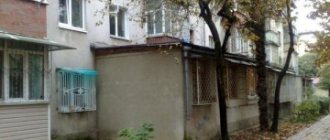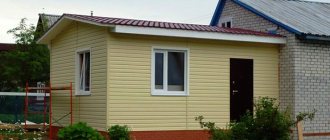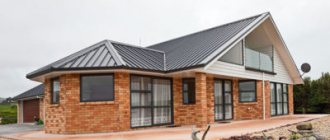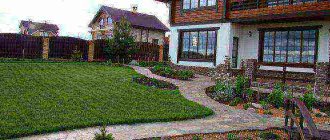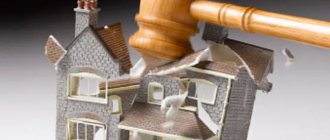What is an extension
Order of the Ministry of Land Construction of the Russian Federation dated 08/04/1998 N 37 (as amended on 09/04/2000) designates an extension as a part of a building located outside the contour of its main external walls.
It is auxiliary to the building and has one (or more) common main wall with it. As a rule, extensions have an internal connection with the main building. These include:
- attached kitchens;
- residential extensions;
- canopy;
- vestibules;
- verandas, etc.
It is important to understand that Russian legislation, namely: clause 14 of Article 1 of the Town Planning Code of the Russian Federation establishes that the reconstruction of capital construction projects is a change in the parameters of a capital construction project, its parts (height, number of floors, area, volume), including the superstructure , reconstruction, expansion of a capital construction project, as well as replacement and (or) restoration of load-bearing building structures of a capital construction project, with the exception of the replacement of individual elements of such structures with similar or other elements that improve the performance of such structures and (or) restoration of these elements.
Thus, the construction of an extension is a reconstruction of the building, due to the fact that it affects the load-bearing and/or enclosing structures of the building to which it is attached, increasing the area and/or height of the house.
Expert advice
Legitimizing a structure is a rather complicated procedure that takes a person’s strength and a lot of time. Legal entities in this regard advise adhering to certain rules:
- The distance from the extension to communications (underground) should not be less than 2.5 meters.
- During construction, load-bearing walls must not be touched , demolished or damaged.
- The building should not be located closer than 1 meter to the neighbors’ fence.
- During construction, it is necessary to use the latest materials and technologies , and also adhere to all existing regulations and standards.
- Appeal to the judicial authorities is carried out in several ways. The application can be sent by mail or brought in person; this is the best option; the secretary will tell you how to fill out the application correctly. If the appeal is not filed in accordance with the rules, the court may refuse the claim.
- Once the application is submitted, there is no need to wait long for a response from the authorities. After a week, it is better to call and find out how things are going with the appeal, whether it was accepted or left unattended.
- The judge may refuse to consider the application due to an incorrectly written application or because the decision was made earlier. There are no other reasons for refusal. If it happens that the application is rejected for unknown reasons, you can try to resubmit it or write a complaint.
- If for any reason a dispute occurs between the owner of the land plot and the owner of the extension , then the decision will be made in favor of the owner of the building only if he manages to prove that the owner of the land was not against the construction.
Due to the illegality of construction, the building cannot be sold, given away, donated, exchanged or inherited in the future. In this situation, you need to consult a specialist; together with him you need to review all the available papers for the site and the house, and also think about further actions.
It will be necessary to carry out an examination of the constructed extension; the expert will need to answer several questions, these include the following:
- are there any violations of the rights and interests of neighbors;
- complies with all necessary safety regulations;
- are there any violations of hygiene and sanitary standards?
In addition to these issues, there may be others at the discretion of the court. After the examination, approval must be made from the municipality. Afterwards, the owner will have to contact the BTI to make all the necessary changes to the technical documentation.
The last stage will be registering the property with Rosreestr and obtaining documents for a new building with a different area and characteristics. But the whole process does not always go smoothly; at any stage of legalization, you can encounter various troubles or be denied documents, in which case the only solution is to go to court. It is for these reasons that you need the help of a qualified lawyer.
Fine for illegal extensions in 2021
If you erected an extension without permission without approval from the administration and without notifying Rosreestr about changes in the parameters of the house, then this fact will be considered a violation.
Such non-compliance with urban planning and administrative legislation entails certain consequences.
Citizens who carry out illegal additions to a private house bear administrative responsibility. Property owners for so-called unauthorized construction or reconstruction are liable in accordance with Article 9.5 of the Code of Administrative Offenses of the Russian Federation, as well as clause 2.222 of the Civil Code of the Russian Federation, which establishes that the violation must be eliminated by demolishing the unauthorized extension or returning the property to its original condition . The perpetrators will be required to carry out this work at their own expense.
Also in accordance with the Code of Administrative Offenses, paragraph 1. Article 9.5 of the Code of Administrative Offenses of the Russian Federation. Reconstruction of a residential building without obtaining permission from the authorities shall entail a fine in the amount of 2,000 to 5,000 rubles.
Emerging nuances
When they can refuse to legalize an extension through the court. The reason may lie in violations found or inconsistencies in the submitted documents. The following reasons will be guaranteed grounds for refusal:
| Location of underground communications | Closer than 2.5 meters from a residential building |
| The work affected the supporting structures of the main facility | And there is a threat to the integrity of the building |
| Used during construction | Outdated technology |
| Poor quality was used | Or unsafe materials |
In addition, other nuances of refusal are possible. For example, the building is recognized as an architectural monument and any changes are simply unacceptable without approval from the authorized authorities.
To a private house on your own land
How to register an extension to a house if the land is owned? If the extension is adjacent to a private house located on its own land, then the following points are of primary importance for legitimizing the structure:
- availability of full ownership of the house and land;
- compliance with construction, sanitary, fire standards;
- consent of all legal co-owners of the house.
It will not be difficult to legalize an extension to a private house if the approved standards are not violated. The situation becomes more complicated in case of the slightest discrepancies and claims from neighbors.
According to the rules for placing objects in areas from the extension to the neighbor’s fence, a distance of at least one meter must be maintained.
Depending on the type of extension, it may be recognized as an auxiliary room or an extension of the living space of the house (a living room is being added, etc.).
In the latter case, a distance of three meters must be maintained from the attached premises to the neighbor’s fence.
Violation of the required distance by at least a couple of tens of centimeters becomes the basis for a decision to demolish the extension. You can avoid demolition only by agreeing with your neighbors to change the boundaries of the plots.
If the house is apartment
Residents of the first floors of apartment buildings sometimes expand their living space by adding a loggia or balcony.
An extension requires legalization through a building permit or a court decision if it changes the technical characteristics of the building.
If the extension does not have a foundation, can be easily assembled and disassembled, and also protrudes from the main building by no more than 12 meters, then to legitimize it, an act on the reconstruction of the premises drawn up by the BTI is sufficient.
To legitimize a capital structure, you will need to coordinate the changes with the residents of the apartment building and obtain consent from all owners of the premises.
It will be necessary to hold a general meeting of residents or obtain written consent from each owner of the premises in the house.
Similarly, it is necessary to obtain the consent of all residents of the house when constructing an extension to a barracks-type residential building or if the house has two owners.
How to apply for a dacha amnesty
If everything is in order with the ownership of the land plot, then you can legalize the extension in 2021 by taking advantage of the “dacha amnesty”.
According to this law, dacha plots in SNT are registered as the property, but an extension to the house can also be registered.
To legitimize the extension, a package of documents is submitted to Rosreestr, consisting of:
- applications for registration of ownership of self-construction;
- applicant's passport;
- legal documents for the land plot;
- cadastral passport for the object (you need to order its production from a cadastral engineer).
Until March 1, 2018, you can register an extension under the dacha amnesty without a building permit and a commissioning certificate. Subsequently, the only option for registration will be to go to court.
In 2021, legalizing an extension to a house will not be difficult if all legal requirements are met.
Otherwise, it will not be possible to register an unauthorized building until the violations are completely eliminated. Therefore, it is advisable to coordinate the construction before carrying out construction work.
If you still have to go to court, then even before filing a statement of claim, you need to take care of the compliance of the structure with current standards.
Legalization of an extension to a house on SNT lands
If the house to which an extension is planned is located on the lands of gardening non-profit partnerships, then registration in 2020-2021 can be carried out in a simplified manner, without obtaining permission from local authorities. This option is possible for the period of the Dacha Amnesty-2, which is valid until March 1, 2021.
So, you turn to a specialist such as a cadastral engineer, who surveys the property and prepares a technical plan for the reconstruction of the house. Then all that remains is to submit the CD to the MFC, wait for Rosreestr’s response and no more difficulties.
It should be noted that during the “Dacha Amnesty-2”, an already constructed extension can be registered in a simplified manner.
So, if you have built or are planning to build an extension in the near future, then it is recommended to register it before March 1, 2021, so that in the future you do not encounter difficulties in the form of obtaining permits from the administration and other issues that complicate the registration of the extension.
When is permission required rather than notification?
In the Town Planning Code (Clause 39, Article 1), an individual housing construction project means housing:
- free-standing;
- up to 3 floors;
- up to 20 m;
- not for division into independent objects (apartments).
Two variants of the procedure coexist in legislation and are applied depending on the parameters of the housing under construction.
It is important to correctly take into account the concept of floors (aboveground, underground, etc.). The explanation was given in letters from the Ministry of Economic Development of the Russian Federation N D23i-2472 (08/23/2013), Rosnedvizhimost N AM/1567 (08/27/2008)
What does it represent?
A construction permit (not a notification) is a document confirming:
- compliance with the design component of the construction of urban planning regulations, planning, land surveying and other norms of the law;
- admissibility according to the intended purpose of the memory.
By whom and where is it issued, in what time frame?
The permitting procedure for approving construction (Article 51 of the Civil Code) is carried out by the same bodies as during the notification procedure - self-government bodies represented by local administrations (their architectural departments).
You must apply at the location of the site, and if the lands are sensitive or protected - to the federal body to which they are subordinate.
The administration must review the application and documents within 30 days from the date of their receipt, and within a 3-day period officials must check whether all the papers are available.
Who gets it, how long does it last?
The permit is valid for 10 years (clause 19 of article 51 of the Civil Code) from the date of its issue. Only the developer (his representative) can apply - in this case, this is the person who owns the site or leases it for the construction of an object to which he will have rights.
The reasons for invalidity are the same as for notices (listed earlier in this article).
Differences between the permitting procedure and the declarative one:
- To authorize the operation of the facility and registration, the developer himself applies to the administration (Article 55 of the Civil Code) and to Rosreestr.
- An expanded package of documentation and additional procedures will definitely be required (Article 51 of the Civil Code), in addition to the documents listed above for the notification procedure:
- project documentation and for these papers a positive conclusion of the mandatory state examination (Article 49 of the Civil Code). Usually, an additional assessment is made from independent accredited expert companies, which increases the chances of a positive response from the government agency;
- urban planning plan of the building;
- results of engineering surveys;
- SPOSU;
- extract of land use and development rules (except for areas that are not subject to urban planning regulations).
Algorithm of actions for permitting for construction
Algorithm of actions for the permitting procedure for the construction of a residential building that does not fall within the parameters of an individual housing construction project under clause 39 of Art. 1 of the Civil Code of the Russian Federation (further all links to this act):
- Development of design and estimate documentation - the timing depends on the performer of these works.
- Mandatory state examination of the project (Article 49) - you must contact the administration (they will indicate the authorized institution). The organization is obliged to carry out the state examination within a maximum of 42 days (clause 7 of article 49).
- Submission of documents and applications to the administration - papers are reviewed within 30 days. (Clause 11.1 Article 49).
- Upon completion of the construction of the facility, the developer must submit a free-form application to the government agency to obtain an operating permit. Officials carry out inspections within 5 days. (Clause 5, Article 55). A corresponding certificate is issued.
- Registration in Rosreestr (application by the developer). The application is considered within 7 days. in person or within 9 days. through MFC.
- applications for a permit to build an individual residential building
- applications for a permit to build an individual residential building
- applications for permission to put a facility into operation
Registration of an extension to a house on individual housing construction lands
Legalizing an extension to a house on individual housing construction lands is somewhat more difficult. In this case, it is impossible to do without notification and approval of local authorities, namely:
- You must notify the administration that you are going to build an extension and obtain some kind of permission from it (Notice of Compliance). The notice period for consideration is 7 days.
- The next stage is when the cadastral engineer surveys the property and prepares a technical plan for reconstruction.
- Next, the Notification of Completion of Reconstruction and the Technical Plan are submitted to the administration for verification.
- And only after receiving a response from the administration, you have the right to submit a technical plan to the MFC for sending to Rosreestr (some administrations send the technical plan to Rosreestr independently. This point must be clarified directly with the local government authority).
- As a result, you will receive an Extract from the Unified State Register of Real Estate with updated data on the characteristics of the house.
It is important that the extension does not violate urban planning norms and rules.
Refusal of the court to legitimize
It is worth considering that even if a complete package of documents is submitted, the court may refuse the claim.
This is possible in the following cases:
- Cables or pipes running underground are located at a distance of less than 2.5 meters.
- During the construction of the structure, load-bearing walls or ceilings were damaged.
- Low-quality materials were used during construction.
- Construction was carried out using outdated technologies.
- Inconsistency of the structure with the design.
The first case fully reflects the legal norm and therefore, before developing the extension project, you need to check this point. In addition, if the structures do not comply with the project, the court will also refuse to satisfy the claim. Such a document is studied most carefully when considering a case, as are acts received from public utilities.
Coordination of the bathhouse project
To obtain permission to build a bathhouse, you will need to contact local authorities, providing a package of documents.
Often the required list includes:
- extract of ownership of the plot;
- house book or detailed drawing of the site;
- project of a future bathhouse.
When independently developing a project, you must strictly adhere to the rules of SNiP. If you are afraid of making a mistake with the standards regarding distance from other buildings, then it is better to turn to architects for help.
In cases where the area of the estate simply does not allow it to meet the standards, the best solution would be to enlist the support of neighbors on both sides. This should not just be an oral agreement, but a written permission certified by a notary. After all, neighbors may change, and new residents may have questions or complaints. Written consent will be your protection and answer in such a situation.
The successful start of construction of a bathhouse requires knowledge of the current legislation from the owners. Compliance with the standards will allow you to operate it unhindered for many years, remaining on good terms with your neighbors.
Location of the bathhouse on the land plot
For the construction of a bathhouse, a site on a hill is selected. This will protect the structure from flooding when the groundwater level rises. It is not permissible to run water pipes, electricity and gas networks, or other utilities under the structure.
Standards for calculating distances when building a bathhouse on a site:
Object Distance to building, m
| House | 8 |
| Forest | 15 |
| Tall trees | 4 |
| Shrubs | 1 |
| Reservoirs | 22 |
| Wells, wells | 12 |
| roadway | 5 |
The bathhouse and the red line are separated from each other at a distance of more than 5 m. This is the name of the boundaries separating lands for public and private use. They are marked in red on maps and plans.
In 2021, according to construction standards, the distance from the fence to the bathhouse was 2.5 m. Now the situation has changed. Incidents of fire in the private sector have become more frequent, so legislation has tightened this point. In accordance with the updated construction standards, the distance from the fence has increased to 3 meters. It is permissible to reduce it to a meter when installing drainage ditches and drains.
Compliance with the norms of distance from the fence when building a bathhouse is a guarantee that you will not break the law and will not disturb anyone.
To the neighbor's fence
The recommended setback from the border of the neighboring plot is 3 m.
As in the previous case, the distance can be increased for reasons of fire and environmental safety. Plus, a building with an attic is a significant shading of the neighboring estate.
When planning a corner structure, the requirements of the regulations often have to be violated, so it is better to discuss this point with the neighbors in advance and obtain their written permission.
If the drainage pit is equipped with a properly thought-out drainage system, then the distance from the bathhouse to the neighbor’s fence will be 0.5 m less.
Distance from outbuildings
When constructing various household buildings, owners quite often do not attach importance to the minimum distance to the neighbors’ plot. This causes disagreements to arise.
In accordance with established standards, the distance from the fence to domestic buildings must be at least one meter.
Construction at a shorter distance is permitted only with prior agreement with neighbors. However, in this case, fire safety rules are violated. All agreements with the owners of the adjacent plot are confirmed in writing.
Sanitary standards prescribe the intervals between outbuildings on one plot of land:
- for a toilet - at least 12 m to the house and at least 8 meters from the well;
- compost heap - at least 12 m from the house and 8 m from the well;
- bathhouse - at least 8 m from the house;
- septic tanks - at least 5-8 m.
SNiP requirements are not laws. These are just recommended standards. Legislative acts of municipalities may change them. It is necessary to clarify the minimum distances for your locality with the local administration.
Distance to neighboring house and buildings, depending on material
If the construction of a bathhouse began before the development of the neighboring plot, the norm is taken from the fence.
If there are other buildings on the adjacent territory of the house, it is necessary to take into account the distance to them. The standards are determined by fire safety requirements from 6 m to 15 m, depending on the wall and roofing material.
Offset from the red line
There are underground and above-ground communications next to the individual construction site. The line of their passage is conventionally called red. It has its own norms for the location of buildings and tree planting from it.
What distance do sanitary standards provide for during construction? The construction of a bathhouse and other buildings from the red line is permitted at a distance of 5 meters, regardless of its passage.
If there is a lane with communications on the side of the site, the deviation from them is also 5 meters. If the red line runs at a distance from the fence, then choose 1 m between the fence and the bathhouse or 5 m from the red line, which ensures both requirements.
According to SNiP 30-102-99 and SNiP 30-02-97, standards for the construction of baths and saunas:
- A brick bathhouse can be placed at a distance of 6 m from a permanent house under construction and standing.
- Wooden with metal and other non-combustible roofing, walls impregnated with anti-flammable substances, at a distance of 8 m.
- If the building is wooden, then the bathhouse should be located at a distance of 10 meters from the stone and brick house.
- The space between wooden buildings must be at least 15 m.
According to sanitary standards, water from drainage pits should not leak into the neighboring area, beyond the fences on all sides. There should be a free space of 1 m around the building.
The distance from the steam room to the neighboring house must be increased if it is planned to burn with wood, and the smoke may go towards the neighboring property. If a neighbor has a blank wall facing the bathhouse, the distance is kept to a minimum according to the standards.
When taking measurements, the protrusion of the base is taken, and in its absence, the wall. It is necessary to take into account the presence of balconies and canopies protruding more than 0.5 m and measure from them. If there is only a poured foundation, other architecture can be ignored.
The bathhouse is attached to the house
The bathhouse can be placed close to the house. Fire safety should be ensured, since baths and saunas are objects of increased fire hazard.
Requirements for the distance to the fence, buildings in neighboring areas and the distance to the red line should be maintained in accordance with SNiP 30-02-97. If you are planning to add a bathhouse, its location should be taken into account in the project. Distance of the extreme points of the base:
- from the fence with an empty area - 1 m;
- at a distance from the red line – 5 m;
- from other wooden buildings - 15 m.
Experts recommend adding a safe electrically heated sauna to your home and creating swimming pools. It is better to install steam rooms and baths separately.
Two-story bathhouse
If you decide to build a two-story bathhouse, you will additionally have to resolve the issue of shading the neighbor’s property. The building should not block the neighboring area from the sun throughout the daylight hours.
The recommended distance between the bathhouse and the neighbor's fence is 3 m. When building on the south side, it is advisable to maintain 5 m
When building at any distance from the fence, fire safety requires that there be a 1 m passage around the entire perimeter around the structure.
Best places for a swimming pool
The favorite procedure of many bathhouse attendants is cooling in the pool after the steam room. Some place this water attribute directly indoors, while others equip a small outdoor pool not far from the home sauna directly on the site. In the case of a thorough construction of an artificial reservoir with a reliable foundation, you must adhere to the following recommendations:
- Retreat at least 200 cm from new buildings.
- The neighbor's fence should be at least 1 m away.
- Should not create obstacles to access to outbuildings on the site.
It is better if the pool is not located on the way to other buildings and attributes of the site. Source megastroyka.com.ua
Based on practical considerations, for a pool, as well as the distance of the bathhouse to the neighbors’ fence, it is recommended to determine at least three meters. After all, possible children's noise or “cultural recreation” can cause certain irritation and serve as a reason for conflict situations to arise.
Legal grounds
According to the norm of the 14th part of the 1st article of the Town Planning Code, the reconstruction of a private house can be recognized as:
- increasing or decreasing its total area (extension);
- increase in number of storeys (superstructure);
- complete replacement of load-bearing structures (reconstruction of walls, roof, etc.).
The addition may subsequently be legalized through the court , but this will only happen if the following conditions are met:
- no one's rights are violated by the reconstruction (neither neighbors nor the municipality);
- SNiPs and codes of regulations were not violated during reconstruction.
In this case, the judge must completely and completely believe you, otherwise the decision may not be in your favor. Or maybe a construction expertise will be required, which will result in financial losses: on average, expertise costs about 25 thousand rubles.
According to the rules of Article 51 of the same code, for reconstruction it is necessary to obtain permission from departmental authorities.
For reference. At the same time, under Article 222 of the Civil Code, houses reconstructed without permission may be recognized as illegal buildings and the extension may be required to be demolished. To avoid such incidents, you need to legally obtain a permit.
Do I need to register a bathhouse?
According to the Civil Code of the Russian Federation (Article 131), mandatory registration of an object is necessary if we are talking about real estate. Therefore, the owner needs to determine whether his bathhouse is movable or immovable property. It all depends on the type of construction. A capital structure with a deep foundation is real estate. It is directly connected to the earth. Separation from the soil without serious damage is impossible. These characteristics of real estate are defined in Art. 130 Civil Code of the Russian Federation. Additionally, pay attention to the presence of a foundation and communications. In this case, you cannot do without registration.
If we talk about mobile saunas made of timber, these are very light structures that represent a large construction set. The disassembled building is brought to the site, where it is assembled element by element. This installation technology allows, if necessary, to disassemble the bathhouse without damaging it. Such structures are considered movable property. When moving, they are transported and re-erected in a new location. They do not require pouring a solid concrete base, nor do they require registration.
The state registration procedure becomes mandatory in three more cases:
- Construction of a bathhouse for commercial use.
- The extension is combined with the cottage.
- If in theory it can be used as a living space.
In 2021, new registration rules began to apply. Now, before construction, the project must be agreed upon with local authorized bodies. Those who have been engaged in construction since last year, but did not manage to complete it, should also contact the administration for approval.
What to do if a neighbor's bathhouse is built too close to the fence between the plots
Compliance with the standards is intended to ensure an appropriate level of safety during the operation of the bathhouse, which means the best quality of rest and maximum benefit from water procedures. However, land plots are often small in size, so it is very difficult to comply with all the rules exactly. The best way out is to seek a compromise with your neighbors. But if the norms of good neighborliness are violated, then it follows:
- try to resolve the conflict at the level of local authorities;
- and if there is no result, go to court, hiring a lawyer experienced in land legislation to protect your interests.
- Sources used in the article:
https://u-datha.ru/company/articles/normy-stroitelstva-bani-na-dachnom-uchastke/ - https://PlanVsem.ru/postroiki/rasstoyanie-ot-bani-do-sosednego-uchastka.htm
- https://estatelegal.ru/zhkx/spory-s-sosedyami/sosed-postroil-banyu-blizko-k-zaboru/
- https://montazh-zaborov.ru/rasstoyanie-ot-zabora-do-bani/
- https://m-strana.ru/articles/na-kakom-rasstoyanii-ot-zabora-mozhno-stroit-banyu/
- https://9ban.ru/normi/570-snip-na-rasstoyanie-ot-bani-do-zabora
- https://septik.guru/normy/rasstoyanie-ot-zabora-do-bani.html
Which extensions require contacting the administration?
Not all extensions require registration and not all become the reason for making changes to the Unified State Register.
Coordination of actions with the municipality and the Cadastral Chamber is mandatory if:
- The reconstruction will affect load-bearing walls;
- The safety of people depends on the reliability of the building (for example, this is an additional room in which family members will live).
Terraces, porches, gazebos and summer kitchens most often do not belong to permanent buildings and do not require an application to the municipality.
But if a major reconstruction was carried out (a room or floor was added, a garage, a bathhouse, a full-fledged kitchen), it needs to be approved. The fact is that during the approval process, on-site specialists evaluate the quality and safety of the extension, and this is especially important for houses in which people will live permanently.
Sanitary standards
Let's consider the sanitary standards that are relevant today in the construction of baths. Their purpose is to make the operation of the building safe for the health of the owners. If there is no central sewer system, an individual sewage system is required. The wastewater ends up in a sealed well and is then pumped out. The second option is preliminary filtration of water with subsequent discharge into the soil. If the site is located in a conservation area, stricter rules apply. If a central sewer system is equipped, the bathhouse drain is connected to it.
Let's consider what sanitary standards must be observed when building a bathhouse:
- The tightness and performance of the chimney.
- Uninterrupted operation of valves.
- Environmentally friendly facing materials. The release of toxic substances when heated is unacceptable. Chipboard and cheap plastic will not work. Polystyrene foam is not used as insulation.
- Properly equipped ventilation. It will prevent the formation of high humidity and condensation.

